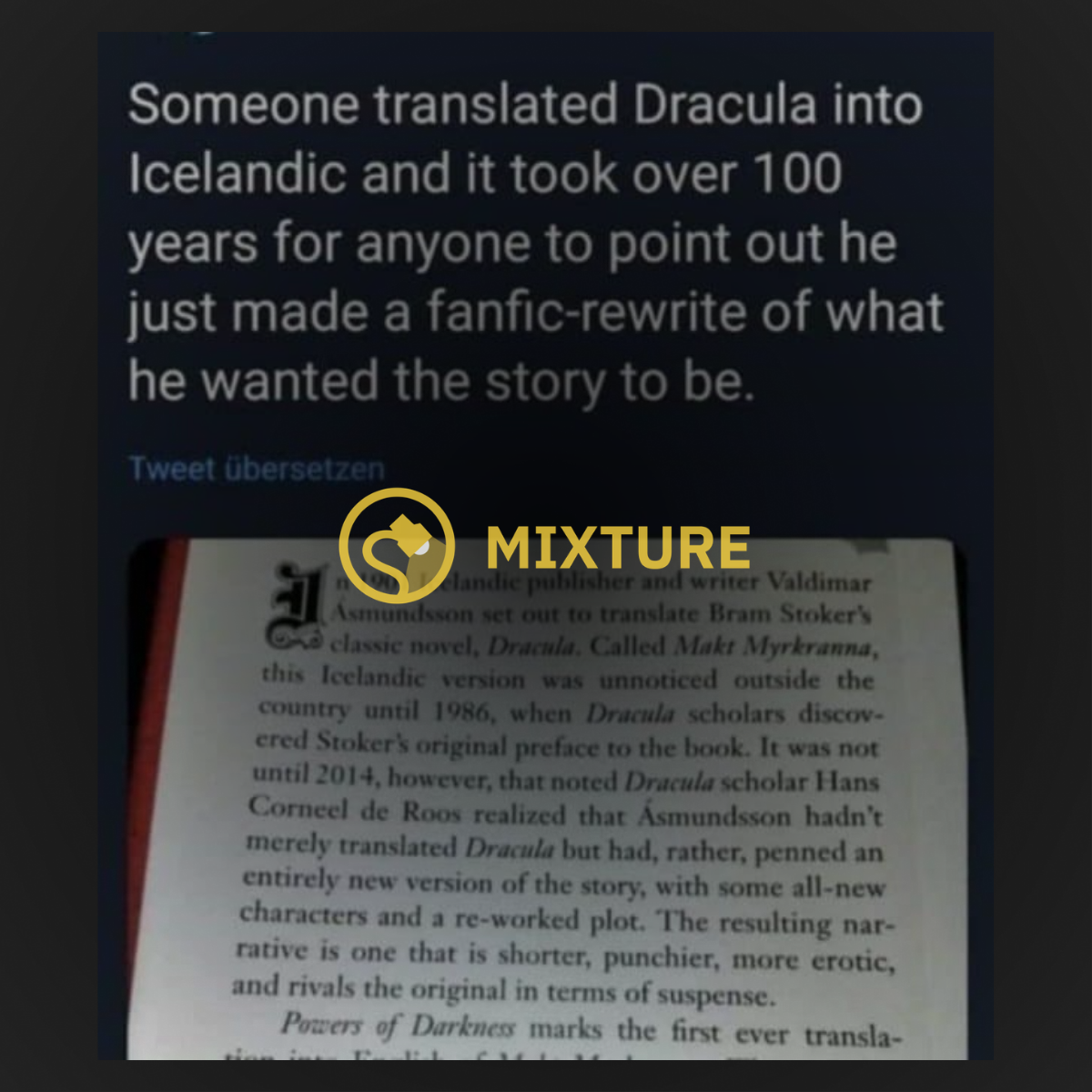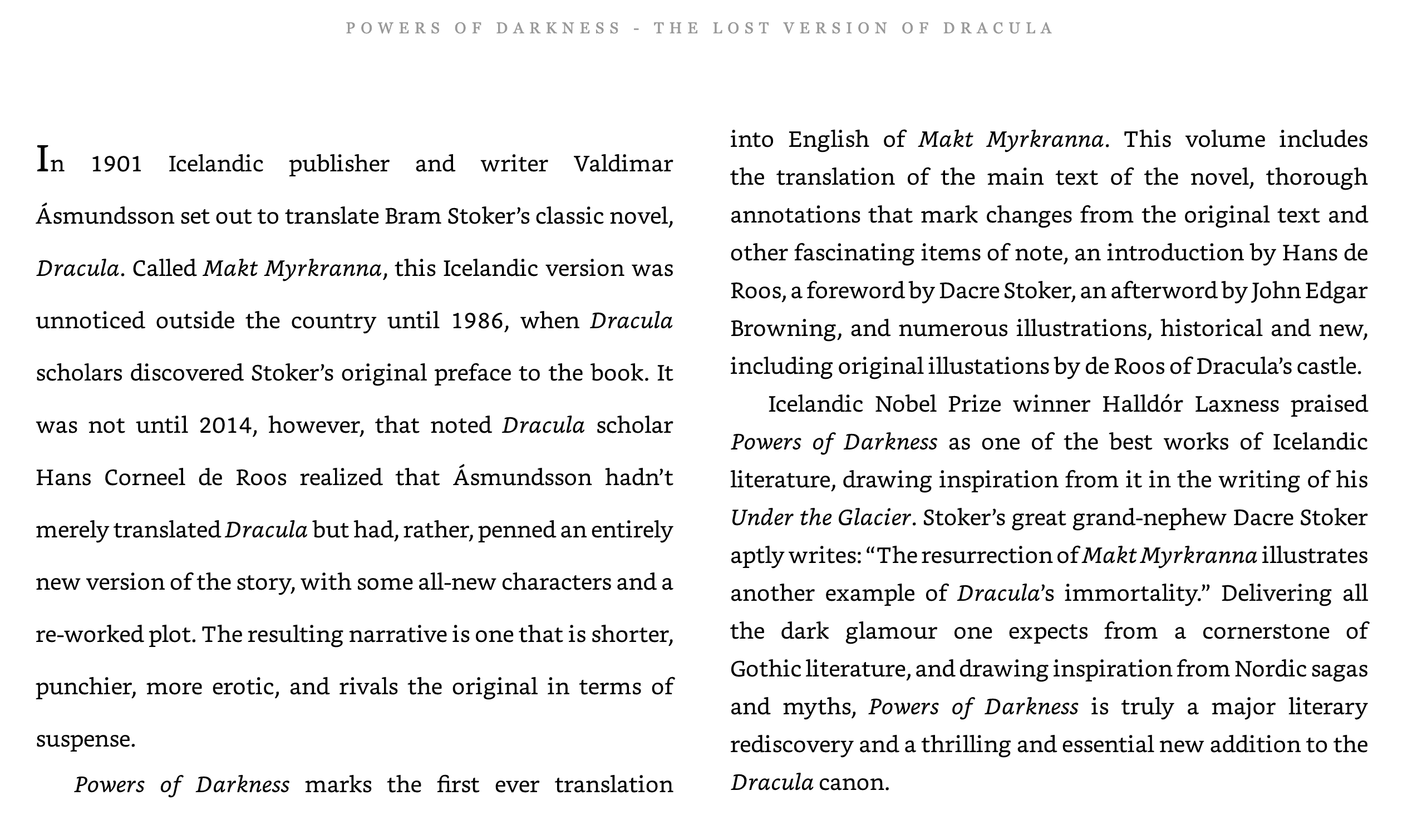In 2021, the story behind a 120-year-old Icelandic version of the classic novel “Dracula” captured the imaginations of social media users, who enthusiastically shared the following summary, originally posted by the Twitter account @ihmerst:
“Someone translated Dracula into Icelandic and it took over 100 years for anyone to point out he just made a fanfic-rewrite of what he wanted the story to be.”

“Dracula,” written by Irish novelist Bram Stoker and first published in 1897, has come to be regarded as a classic work in the genres of horror and Gothic fiction and helped popularize vampire folklore in the English-speaking world. It has also inspired a vibrant field of academic research into the social and cultural themes upon which the novel touches, as well as the life of Stoker and the origins of “Dracula.”
One particularly fascinating point of interest involves the existence of alternative versions of the novel, published in Icelandic and Swedish around the turn of the 20th century. The description posted by @ihmerst contained a measure of truth, but oversimplified what is a complicated and unfinished area of research.
‘Powers of Darkness’
The photograph contained in @ihmerst’s tweet showed a snapshot of the introduction to Hans Corneel de Roos’ 2017 English translation of “Makt Myrkranna” (“Powers of Darkness”), the Icelandic book in question. It was written by journalist Valdimar Ásmundsson, first serialized in his newspaper Fjallkonan in 1900, and later published as a book which, remarkably, included a preface attributed to Stoker himself.
A more clearly legible version of de Roos’ introduction can be viewed below:

Up until the 2010s, “Makt Myrkranna” remained untranslated from Icelandic and was presumed to be simply a shortened translation of Stoker’s original English text. However, de Roos discovered that the plot of the book differed drastically from that of “Dracula,” including new characters, more explicit sexual themes and imagery, and a significant shift in style away from the epistolary (letter-writing) format of the original.
In 2014, de Roos described “Makt Myrkranna” as the first translation of “Dracula” and speculated that, in light of elements contained in Stoker’s preface, the Irish writer himself may have endorsed “Makt Myrkranna” or even collaborated with Ásmundsson on it.
De Roos’ findings made waves in the world of “Dracula” scholarship, and when he published the English translation of “Makt Myrkranna” in 2017, it attracted mainstream news coverage around the world.
However, the publicity surrounding de Roos’ findings prompted yet another plot twist, as it were. In 2017, the Swedish fantasy writer Rickard Berghorn recognized in the title of the Icelandic text, “Makt Myrkranna,” a clear similarity with the title of a Swedish translation of Stoker’s novel — “Mörkrets makter,” which also translates as “Powers of Darkness.”
Berghorn made two startling discoveries: first, that serialized versions of “Mörkrets makter” had been published in Swedish newspapers beginning in 1899 (that is, before the Icelandic text was published); and second, that the Swedish versions also constituted a radical departure from Stoker’s 1897 novel, rather than a straightforward translation.
Since 2017, something of a consensus has emerged that, rather than constituting a modified and embellished version of “Dracula,” based on the original English text, Ásmundsson’s Icelandic text was in fact a modified translation of earlier Swedish texts. As a result, @ihmerst’s claim that “someone translated ‘Dracula’ into Icelandic” should now be regarded as outdated and inaccurate.
However, some key questions remain. Who wrote the preface to “Powers of Darkness,” which was included in both the Swedish and Icelandic texts and attributed, perhaps fraudulently, to Stoker? Was Stoker even aware in advance of the Swedish text (and subsequent Icelandic text), much less involved in its creation? What was the identity of the unnamed Swedish newspaper editor responsible for “Mörkrets makter”? Was the Swedish text simply “fan fiction” — an unauthorized alternative version of “Dracula” masquerading as a translation — or could it have been based on a much earlier draft of Stoker’s own novel?
Jarlath Killeen, head of the School of English at Trinity College Dublin (which Stoker himself attended), and an expert in Gothic and Victorian Irish and British literature, has edited and written several books and articles on Stoker and “Dracula.” He told Snopes that scholars were continuing to research and debate those questions and others, but the precise origins of the Nordic texts remained “very unclear and very murky,” for now.
No comments:
Post a Comment